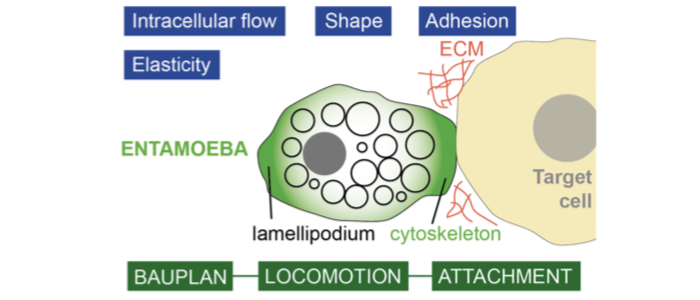P15 - Dynamics and forces during first stages of Entamoeba tissue invasion
Cellular forces during Entamoeba tissue invasion
Pathogenic amoebae are the causative agents of many severe diseases, including amoebiasis, amoebic encephalitis and amoebic keratitis. Most of these diseases could be avoided by applying strict hygiene rules, but even in developed countries diseases caused by amoeboe occur and can lead to severe infections with high psychological strain for the patients. An important example of such a disease is acanthamoeba keratitis, which is typically due to insufficient cleaning of contact lenses and leads to painful destruction of the cornea that ultimately causes blindness. Another example is an infection with Naegleria fowleri, which can be transmitted from contaminated pools and can cause a primary amoebic meningoencephalitis that is in most cases fatal. Whereas Acanthamoeba and Naegleria are free-living amoebae, amoebae of the Entamoeba species are found in animals and humans as internal parasites. Entamoeba histolytica causes amoebiasis and is an important cause of morbidity and mortality in developing countries (~100,000 deaths per year), with liver abscesses and chronic colitis being especially dangerous consequences. Tissue invasion and destruction are essential for the progression of diseases caused by amoeba. In Entamoeba infections, host tissue is destroyed by killing target cells through pore-forming proteins (amoebapore), which are excreted from the amoebae. Remodeling of the extracellular matrix also plays an essential role for tissue invasion by Entamoeba histolytica. In addition, trogocytosis is also involved in target-cell killing by Entamoeba, similar to the gnawing of lymphocytes on antigen-presenting cells. Due to the relevance of trogocytosis in Entamoeba it has been suggested that amoeba-exerted forces also play a major role for extracellular matrix and target-cell destruction by this parasite species.

The proposed research project aims at investigating the interplay of intracellular motion and cellular motion as well as the impact of cellular forces during the first stages of tissue invasion by parasitic amoebae. By combining experimental methods from biophysics and materials science with theoretical approaches from statistical physics, we plan to achieve a novel and unique understanding of the physical versus biochemical mechanisms of amoeba-induced tissue invasion and destruction.
The research project will address three core research areas: (i) The physics of the interaction of parasites with their microenvironments, (ii) parasitic locomotion in natural and nature-inspired microenvironments, and (iii) the mechanics of parasite attachment to host structures.







